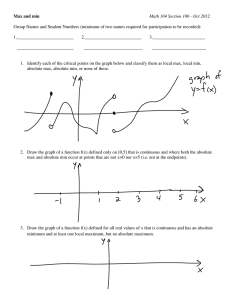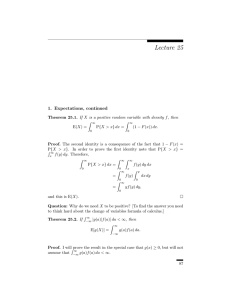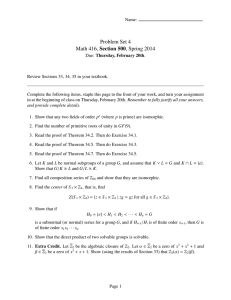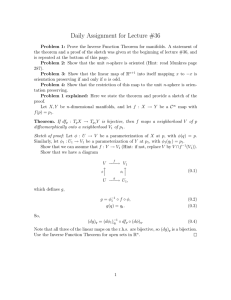Localization of solutions to stochastic porous media equations: finite
advertisement
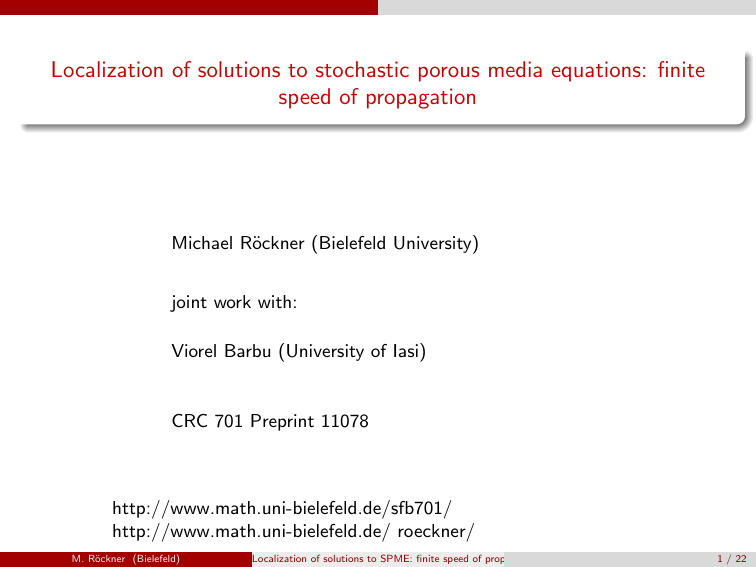
Localization of solutions to stochastic porous media equations: finite
speed of propagation
Michael Röckner (Bielefeld University)
joint work with:
Viorel Barbu (University of Iasi)
CRC 701 Preprint 11078
http://www.math.uni-bielefeld.de/sfb701/
http://www.math.uni-bielefeld.de/ roeckner/
M. Röckner (Bielefeld)
Localization of solutions to SPME: finite speed of propagation
1 / 22
Table of contents
1
Introduction and Framework
2
The main results
3
Sketch of Proof for Theorem II
M. Röckner (Bielefeld)
Localization of solutions to SPME: finite speed of propagation
2 / 22
Introduction and Framework
Let O be a bounded and open domain of Rd , d = 1, 2, 3, with smooth boundary ∂O.
Consider the stochastic porous media equation
dX − ∆(|X |m−1 X )dt = σ(X )dWt ,
X =0
X (0) = x
t ≥ 0,
on ∂O,
in O,
(SPME)
where m ≥ 1, ∆ is the Dirichlet Laplacian and Wt is a Wiener process in L2 (O) of the
form
Wt =
N
X
βk (t)ek
k=1
for some N ∈ N, where
M. Röckner (Bielefeld)
Localization of solutions to SPME: finite speed of propagation
3 / 22
Introduction and Framework
{βk }Nk=1 are independent Brownian motions on a filtered probability space {Ω, F, Ft , P},
while {ek }k∈N is an orthonormal system in L2 (O) and
σ(X )Wt =
N
X
µk Xek βk (t),
k=1
where µk , 1 ≤ k ≤ N, are nonnegative numbers.
We assume that ek ∈ C 2 (O) and
N
X
µ2k ek2 (x) ≥ ρ > 0, ∀x ∈ O.
(P)
k=1
M. Röckner (Bielefeld)
Localization of solutions to SPME: finite speed of propagation
4 / 22
Introduction and Framework
Let H := H −1 (O) be the dual of H01 (O) with norm | · |−1 .
Definition 1.1
An H-valued continuous Ft -adapted process X = X (t, ξ) is called a strong solution to
(SPME) on (0, T ) × O if
X ∈ L2 (Ω, C ([0, T ]; H)) ∩ L∞ (0, T ; L2 (Ω × O)),
|X |m−1 X ∈ L2 (0, T ; L2 (Ω, H01 (O))),
Z t
Z t
X (t) = x +
∆(|X (s)|m−1 X (s))ds +
σ(X (s))dWs , t ∈ [0, T ].
0
(SPME’)
0
Here we use the standard notation Lp (E ; B), p ∈ [0, ∞], for a measure space (E , E, µ)
and a Banach space B, i.e., Lp (E ; B) denotes the space of all B-valued measurable maps
f : E → B such that |f |pB is µ-integrable.
M. Röckner (Bielefeld)
Localization of solutions to SPME: finite speed of propagation
5 / 22
The main results
Our main result says that if 1 < m ≤ 5, which is the case of slow diffusion under
stochastic perturbation, then the process X = X (t, ·) has the property of “finite speed
propagation of disturbances” in the following sense (see [Antontsev/Shmarev,
Nonlinear Analysis 2005]):
If x = 0 in Br (ξ0 ) = {ξ ∈ Rd ; |ξ − ξ0 | < r } ⊂ O, then there is a function
r ( · , ω) : [0, T ] → (0, r0 ), decreasing in t, such that X (t, ξ, ω) = 0 in Br (t,ω) (ξ0 ) for
0 ≤ t ≤ t(ω), for P-a.e. ω ∈ Ω.
In this sense, we speak about finite speed of propagation of X (t).
Remark
In the case 0 < m < 1 (fast diffusion) and if d = 1 also for m = 0 the solution
X = X (t, x) has the finite extinction property with positive probability (see
[Barbu/DaPrato/R., CRAS 2009, CMP 2009 resp.]) which also can be seen as a
localization property for the solutions of (SPME).
M. Röckner (Bielefeld)
Localization of solutions to SPME: finite speed of propagation
6 / 22
The main results
Our technique of proof is based on the results in [Barbu/R., JDE 2011], which allow to
transform the problem to a deterministic partial differential equation (PDE) with random
coefficients. This latter PDE, however, is not of porous media or any other known type,
so that the necessary estimates become more complicated.
M. Röckner (Bielefeld)
Localization of solutions to SPME: finite speed of propagation
7 / 22
The main results
Theorem I
Assume that x ∈ Lm+1 (O). Then (SPME) has a unique strong solution X . If x ≥ 0 a.e.
in O, then X ≥ 0 a.e. in Ω×(0, T )×O and
Z T Z Z
2
E
ds ∇(|X |m−1 X ) dξ + sup E
|X (t, ξ)|m+1 dξ
t∈[0,T ]
0
O
O
Z
≤C
|x|m+1 dξ.
O
M. Röckner (Bielefeld)
Localization of solutions to SPME: finite speed of propagation
8 / 22
The main results
Remark
Existence and uniqueness, as well as nonnegativity of solutions to (SPME) has been
discussed in several papers (see e.g. [Barbu/DaPrato/R., Indiana Univ. Math. J.
2007], [Ren/R./Wang, JDE 2007]). But the notion of solution was different. More
precisely, solutions were not required to satisfy (SPME’), but only that
Z t
t 7→
|X (s)|m−1 X (s)ds
0
H01 (O),
is a continuous process in
and that (SPME’) holds with the Laplacian in front
of the ds-integral. We refer to [R./Wang, JDE 2008] for a detailed discussion. In the
present paper, we need the stronger notion of solution as in Definition 1. For recent
results on existence of such “strong” solutions for general SPDE of gradient type,
including our situation as a special case, see [Gess, arXiv 2011].
M. Röckner (Bielefeld)
Localization of solutions to SPME: finite speed of propagation
9 / 22
The main results
Below, we are only concerned with small T > 0, so we may assume that T ≤ 1.
Furthermore, for a function g : [0, 1] → R, we define its α-Hölder norm, α ∈ (0, 1), by
|g |α := sup
s,t∈[0,1]
s6=t
|g (t) − g (s)|
·
|t − s|α
Fix α ∈ (0, 12 ) and define the “Hölder ball of radius R”
Ωα
H,R = {ω ∈ Ω | |βk (ω)|α ≤ R, 1 ≤ k ≤ N} .
Then, Ωα
H,R % Ω as R → ∞ P-a.s.
Now, we are ready to formulate our main result.
M. Röckner (Bielefeld)
Localization of solutions to SPME: finite speed of propagation
10 / 22
The main results
Theorem II
Assume that d = 1, 2, 3 and 1 < m ≤ 5, and that x ∈ L∞ (O), x ≥ 0, is such that
support{x} ⊂ Brc0 (ξ0 ).
Let for R > 0
!−1
N
ρ 1/2
X
1
−1
δ(R) :=
c1
|∇ek |∞ µk
m+1 2
k=1
"
!#!
N
X
1
1
× exp
(1 − m)
c2 +
|ek |∞ µk
∧ 1,
2
2
k=1
where c1 , c2 (depending on R) are as in the Key Lemma below and ρ as in (P).
M. Röckner (Bielefeld)
Localization of solutions to SPME: finite speed of propagation
11 / 22
The main results
Theorem II (continued)
Define for T ∈ (0, 1]
(
δ(R)
ΩT
:=
)
sup |βk (t)| ≤ δ(R) for all 1 ≤ k ≤ N
.
t∈[0,T ]
δ(R)
Then, for ω ∈ ΩT ∩ Ωα
H,R , there is a decreasing function r (·, ω) : [0, T ] → (0, r0 ], and
t(ω) ∈ (0, T ] such that for all 0 ≤ t ≤ t(ω),
X (t, ω) = 0 on Br (t,ω) (ξ0 ) ⊃ Br (t(ω),ω) (ξ0 ), and
X (t, ω) 6≡ 0 on Brc(t,ω) ⊂ Brc(t(ω),ω) (ξ0 ).
δ(R)
Since ΩT
(L)
% Ω as T → 0 up to a P-zero set, and hence
!
[ [ δ(M)
α
P
Ω1/N ∩ ΩH,M = 1,
M∈N N∈N
it follows that we have finite speed of propagation of disturbances (“localization”) for
(Xt )t≥0 P-a.s..
M. Röckner (Bielefeld)
Localization of solutions to SPME: finite speed of propagation
12 / 22
The main results
As follows from the proof, r (t, · ), t ∈ [0, T ], is an {Ft }-adapted process.
The conditions m ≤ 5 and x ∈ L∞ (O) might seem unnatural, but they are technical
assumptions required by the work [Barbu/R., JDE 2011] on which the present proof
essentially relies.
M. Röckner (Bielefeld)
Localization of solutions to SPME: finite speed of propagation
13 / 22
Sketch of Proof for Theorem II
Sketch of Proof for Theorem II
For the proof we shall assume ξ0 = 0 ∈ O and set Br = Br (0). We consider the
transformation from [Barbu/DaPrato/R., CMP 2009]
y (t) = e µ(t) X (t), t ≥ 0,
where µ(t, ξ) = −
N
X
µk ek (ξ)βk (t), t ≥ 0, ξ ∈ O.
k=1
Then
dy
1
− e µ ∆(y m e −mµ ) + µ
ey = 0, t > 0, P-a.s.,
dt
2
y (0) = x,
y m ∈ H01 (O), ∀t > 0, P-a.s.,
(TPME)
where
µ
e :=
N
X
µ2k ek2 .
k=1
By Theorem I, we have P-a.s.
y ≥ 0, y m (t) ∈ H01 (O) ∩ L
M. Röckner (Bielefeld)
m+1
m
(O), a.e. t ≥ 0.
Localization of solutions to SPME: finite speed of propagation
14 / 22
Sketch of Proof for Theorem II
Sketch of Proof for Theorem II
Furthermore, by [Barbu/R., JDE 2011]:
Key Lemma
Assume that 1 ≤ d ≤ 3 and m ∈]1, 5]. Then, if x ∈ L∞ (O), the solution y to (TPME)
satisfies P-a.s. for every T > 0
y ∈ L∞ ((0, T ) × O) ∩ C ([0, T ]; H),
dy
y m ∈ L2 (0, T ; H01 (O)),
∈ L2 (0, T ; H).
dt
Moreover, for every T ∈ (0, 1], α ∈ (0, 21 ), R > 0, there exist constants c1 , c2 > 0
depending on α, R, O, |x|∞ , max (|ek |∞ , |∇ek |∞ , |∆ek |∞ ), but not on T such that
1≤k≤N
P-a.s. on Ωα
H,R ,
"
#
ky kL∞ ((0,T )×O) ≤ c1 exp c2 max
sup
1≤k≤N t∈[0,T ]
M. Röckner (Bielefeld)
|βk (t)| .
Localization of solutions to SPME: finite speed of propagation
15 / 22
Sketch of Proof for Theorem II
Sketch of Proof for Theorem II
Consider and the localizing function ψε (ξ) := %ξ (|ξ|), ξ ∈ O, where %ε is smooth with
1[0,r +ε] ≤ %ε ≤ 1[0,r +2ε] . Then multiply (TPME) by ψε and integrate over O to obtain:
1
m+1
Z
Z t Z
(y (t, ξ))m+1 ψε (ξ)dξ+ ds
∇(ye −µ )m ·∇(e µ y m ψε )dξ
O
O
0
1
+
2
Z
t
Z
ds
0
O
µ
ey
m+1
ψε dξ =
1
m+1
Z
x m+1 ψε dξ.
O
On the other hand, we have
Z
Z
∇(ye −µ )m · ∇(e µ y m ψε )dξ =
|∇(ye −µ )m |2 ψε e (m+1)µ dξ
O
O
Z
1
(∇(ye −µ )m · ∇µ)e µ y m ψε dξ
+(m + 1)
2 O
Z ξ
∇(ye −µ )m ·
(s, ξ)ρ0ε (|ξ|)(e µ y m )(s, ξ)dξ,
+
|ξ|
O
M. Röckner (Bielefeld)
Localization of solutions to SPME: finite speed of propagation
16 / 22
Sketch of Proof for Theorem II
Sketch of Proof for Theorem II
Then
1
m+1
Z
y m+1 (t, ξ)dξds
Br +ε
Z
t
+
Z
0
+
≤
ψε e (m+1)µ |∇(ye −µ )m |2 dξ ds
ds
1
2
t
Z
Z
ds
0
Br +2ε
1
m+1
Z
−(m + 1)
Z tZ
−
0
−→
ε→0
φ(r , t)
Br +2ε
ψε x m+1 dξ
ZBr t+2ε
Z
0
(∇(ye −µ )m · ∇µ)ψε e µ y m dξ ds
ξ
∇(ye −µ )m ·
(s, ξ)(e µ y m )(s, ξ)ρ0ε (|ξ|)dξ ds.
|ξ|
Br
+2ε
Br +2ε \Br +ε
M. Röckner (Bielefeld)
ψε µ
ey m+1 dξ ds
Localization of solutions to SPME: finite speed of propagation
17 / 22
Sketch of Proof for Theorem II
Sketch of Proof for Theorem II
Here define “energy function”
Z tZ
φ(t, r ) :=
|∇(ye −µ )m |2 e (m+1)µ dξ ds, t ∈ [0, T ], r ≥ 0.
0
Br
In order to prove (L), our aim is to show that φ satisfies a differential inequality of the
form
∂φ
δ(R)
(t, r ) ≥ Ct θ−1 (φ(t, r ))δ on Ωα
for t ∈ [0, T ], r ∈ [0, r0 ],
H,R ∩ ΩT
∂r
where 0 < θ < 1 and 0 < δ < 1 and from which (L) will follow (by elementary
arguments).
M. Röckner (Bielefeld)
Localization of solutions to SPME: finite speed of propagation
18 / 22
Sketch of Proof for Theorem II
Sketch of Proof for Theorem II
On the other hand, we have as ε → 0
t
Z
0
Z
Br +2ε \Br +ε
ξ
| ∇(ye −µ )m ·
e µ y m ρ0ε (| · |)|dξ ds
|ξ|
!1
Z tZ
0
Br +2ε \Br +ε
|ρ0ε (| · |)| |∇(ye −µ )m |2 e (m+1)µ dξ ds
!1
Z tZ
2
×
e
0
1
%0ε ∼ ε
2
≤
Br +2ε \Br +ε
M. Röckner (Bielefeld)
(1−m)µ 2m
y
|ρ0ε (|
· |)|dξ ds
−→
t
Z
→
Z
1
2
∂φ
(t, r )
∂r
y 2m e (1−m)µ dξ
ds
0
1
2
.
Σr
Localization of solutions to SPME: finite speed of propagation
19 / 22
Sketch of Proof for Theorem II
Sketch of Proof for Theorem II
Setting
K (t, r ) =
1
2
Z tZ
0
H(t, r ) = sup
Br
µ
ey m+1 ds dξ
1
m+1
Z
y
m+1
(s, ξ)dξ, 0 ≤ s ≤ t
,
Br
and letting ε → 0 we obtain for r ∈ (0, r0 ],
H(t, r ) + φ(t, r Z
) + ZK (t, r )
t
≤ (m + 1)
|(∇(ye −µ )m · ∇µ)e µ y m |dξ ds
0
Br
1 Z t Z
1
2
2
∂φ
2m (1−m)µ
(t, r )
y e
dξ ds
,
+
∂r
0
Σr
since x ≡ 0 on Br .
M. Röckner (Bielefeld)
Localization of solutions to SPME: finite speed of propagation
20 / 22
Sketch of Proof for Theorem II
Sketch of Proof for Theorem II
By Cauchy–Schwarz and (P), we have (since m =
Z tZ
|(∇(ye −µ )m · ∇µ)e µ y m |dξ ds
0
Br
m+1
2
+
m−1
)
2
1/2
≤ ky m−1 e (1−m)µ |∇µ|2 kL∞ ((0,T )×O)
Z t Z
1 Z t Z
2
m −mµ 2 (m+1)µ
×
ds
|∇(y e
)| e
dξ
ds
0
Br
1/2
1
1
0
y
m+1
1
2
dξ
Br
≤ CT k|∇µ|2 kL∞ ((0,T )×O) (φ(t, r )) 2 (K (t, r )) 2
1
≤
(φ(t, r ) + K (t, r )),
2(m + 1)
δ(R)
∀t ∈ (0, T ], r ∈ (0, r0 ], on Ωα
,
H,R ∩ ΩT
by the definition of δ(R) and by the “Key Lemma”.
M. Röckner (Bielefeld)
Localization of solutions to SPME: finite speed of propagation
21 / 22
Sketch of Proof for Theorem II
Sketch of Proof for Theorem II
Hence
1 Z t Z
1
2
2
∂φ
(t, r )
ds
y 2m e (1−m)µ dξ
∂r
0
Σr
δ(R)
∀t ∈ [0, T ], r ∈ [0, r0 ], on Ωα
,
H,R ∩ ΩT
H(t, r ) + φ(t, r ) + K (t, r ) ≤ 2
where the surface integral on the right-hand side can be estimated in terms of t 1−θ , φ
and H to give the desired
∂φ
δ(R)
(t, r ) ≥ ct θ−1 (φ(t, r ))δ on Ωα
for t ∈ [0, T ], r ∈ [0, r0 ].
H,R ∩ ΩT
∂r
For this we modify a technique form [Diaz/Veron, TAMS 1985] based on the following
interpolation-trace inequality
|z|L2 (Σr ) ≤ C (|∇z|L2 (Br ) + |z|Lσ+1 (Br ) )θ |z|1−θ
,
Lσ+1 (Br )
for all σ ∈ [0, 1] and θ = (d(1 − σ) + σ + 1)/(d(1 − σ) + 2(σ + 1)) ∈
this inequality for z = (y m e −µ )m and σ = m1 .
M. Röckner (Bielefeld)
Localization of solutions to SPME: finite speed of propagation
1
2
, 1 . We apply
22 / 22
